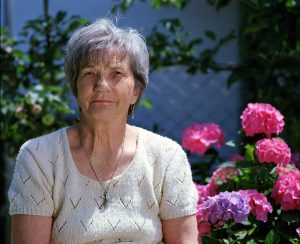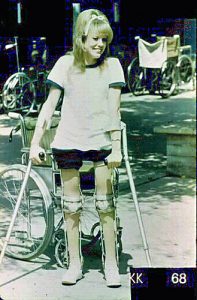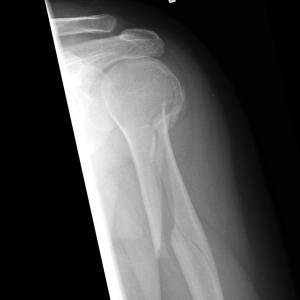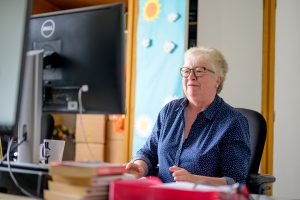6 Gayle Smith

By Bernadette O’Shannessy & Danielle Hitch
Gayle is a 65 year old woman from an English speaking Anglo-Australian background. She has always been passionate about social justice and has had a long career with not-for-profit and charity organisations as an advocate and activist for people experiencing disadvantage. Gayle is a dedicated gardener and is currently transitioning her garden to drought-resistant native plants. Gayle also enjoys the arts, particularly live music and theatre productions. She has been in a long-term relationship with Jenny for the past 30 years, and they spent most of their life together in a larger rural town two hours east of their current location. They have a cat called Mickey, but Gayle is a self-described ‘dog person’ and doesn’t spend much time with him.
“I know life wasn’t meant to be easy, but in a country like Australia it should at least be fair.”
Home Life
Gayle lives with Jenny in a two-bedroom unit close to the centre of their town. It is also within walking distance of the lakefront and the bridge, which leads to an ocean beach. Jenny (aged 70) had a long career as an accountant and ran a busy and very successful practice. They downsized when they moved seven years ago and own their unit outright. Both Gayle and Jenny receive the Aged Pension, and their finances are, therefore, somewhat constrained. However, she ensures they have access to all their entitlements, and her partner’s professional background helps them to live within their means. Their home is in good condition, but both find home maintenance tasks harder as they age.
Gayle’s two older brothers are farmers in regional Victoria but are over three hours away by car. She sees them two or three times a year and really enjoys catching up with her nieces and nephews face-to-face. She frequently uses Zoom to keep in touch with her extended family and is active in social justice groups on several social media platforms. One of Gayle’s closest long-term friends (Cathy) lives five minutes away, and they used to have dinner every week with her and her husband (Gary) at the local bistro. However, Cathy and Gary moved into aged care six months ago due to their respective health issues, and they can no longer participate in many community activities. Despite making a conscious effort when they arrived in town, Gayle and Cathy have no other close friends locally but do have a wide range of acquaintances. However, Gayle has several online friends with shared interests with whom she keeps in regular contact.
“It’s hard making new friends at our age, but we’ve got each other, and that’s enough.”
Community

Gayle and Jenny moved to Lakes Entrance seven years ago from their original home in Traralgon. The move coincided with Jenny’s retirement, and they were attracted to the natural beauty, laid-back atmosphere of the town and the chance to spend more time with Cathy and Gary. Lakes Entrance has a population of around 8,600 people and is a growing community, including many retirees. The town attracts tourists in the summer when up to 50,000 additional people visit the area to take advantage of the lake system and Ninety Mile Beach. Gayle has mixed feelings about this influx of tourists – while they add a lot of colour and buzz to her town, they also place a significant strain on local services and facilities.
Lakes Entrance has a community health clinic with a wide range of services and two other general practitioner (GP) clinics, but the nearest hospital is 40 kilometres away in Bairnsdale. The town has three supermarkets, numerous general shops and a wide selection of cafes. Many kilometres of parkland are in the immediate surrounds, and a council-run Aquadome with indoor heated pools.
Gayle has lived in the Gippsland region all her life and grew up in Moe. She left school at 16 and worked in several administration and secretarial positions before moving to Traralgon in her early twenties. Over time, she developed further skills in welfare and community development, which became the focus in the second half of her career. Gayle worked for several non-profit welfare organisations in the region and deeply enjoyed supporting local people to overcome social disadvantages and improve their quality of life. She continued to work casually as an equality advocate for a regional organisation. She enjoyed the challenge of working with the different issues experienced by the residents of this smaller community. Gayle was also on the board of several local community organisations and had meetings to attend in these roles on a weekly basis. She and Jenny also developed links with the local branch of the University of the Third Age (U3A), which provides courses and social activities for people over 50 who are retired or semi-retired. They visited the Senior Citizens Club on several occasions but chose not to join as they weren’t interested in many of the activities on offer.
“The Club just does nice, sedate activities for old people… I know I’m old, but I guess I don’t want to be a typical old lady.”
Health
Gayle was a healthy and active young child who loved rough and physical play with her brothers. She contracted polio at the age of 4, in one of the last outbreaks following the introduction of vaccinations. During the acute phase of her illness, her lower limbs became paralysed, and she spent many months in a Thomas Splint, which kept her lower limbs immobilised. Overall, she spent ten months in a hospital in Melbourne with limited visits from her parents or other family members due to its distance from home. She has few memories of her time in the hospital besides feeling happy while sitting in the sun on an open-air balcony with other children. However, Gayle clearly remembers the day she came home from the hospital and how her mother cried joyfully at her return. Gayle also required ongoing rehabilitation for the next three years, which she received at the local hospital. She was left with residual lower limb bilateral weakness and used orthoses (called callipers) and crutches to support her mobility until she contracted COVID-19. Despite her physical disability, her family expected her to participate in community life fully and encouraged her to “be the same as every other kid“.
“I don’t think they quite understood how hard it was for me sometimes, but their positive attitude gave me confidence.”
Polio in Australia
For more information about the experience of Australians during Polio outbreaks, please read:
“Defining moments: Polio vaccine introduced in Australia” from the National Museum.
“Remembering Australia’s Polio scourge“: from the University of Melbourne

Besides her physical disability, Gayle has experienced good health throughout her life. She always prioritised and was mindful of her well-being by maintaining a good diet and as much physical activity as possible. Gayle is an NDIS participant but only uses the scheme to support and fund her orthoses. She only sees a GP two to three times per year for routine queries. Since moving to Lakes Entrance, she has found it difficult to maintain continuity of care with a local doctor. In common with many rural towns, there is significant turnover in staff, and she never seems to see the same clinician twice. Gayle maintained her usual activities as much as possible during the initial lockdowns in 2020. She was thankful that her regional community was not subjected to the same strict restrictions as metropolitan Melbourne.
Gayle has experienced disability discrimination throughout her life, including exclusion on the basis of stigma and physical environment barriers. She found this very distressing as a younger person but has reluctantly accepted that this is often part of daily life for people with disability.
“I can pretty much look after myself, but I wish I didn’t have to go through my whole life story every time.”
COVID-19
Acute Infection

Gayle acquired COVID-19 in a Melbourne hospital, where she had been admitted following a serious injury. During a visit to the supermarket, her crutch slipped on a spilled drink at the local shopping centre and fell heavily. She badly fractured her proximal humerus and was transported by ambulance to Bairnsdale Hospital. Doctors determined she required specialist orthopaedic care due to the severity of her fracture, and she was transferred to a major tertiary hospital in the city.
Gayle had surgery to repair her fracture and made an excellent recovery over eight days. The team planned to discharge her home in the next 24-48 hours once community-based rehabilitation and follow-up care had been arranged. However, on the ninth day of her admission, she began to develop respiratory symptoms and headaches. The hospital soon identified an outbreak of the Delta strain of COVID-19 on the ward, which eventually affected five patients and twelve staff members. While Gayle understood the ward team were doing their best, Jenny was extremely angry that she got COVID-19 in “the very place she should be safest”. After several angry conversations with the ward staff, she was banned from calling in, and Gayle only received phone calls from her brothers once or twice a week.
Gayle’s symptoms were relatively acute and mild, and most of her respiratory symptoms resolved within the first four days. However, she continued to experience dizziness, breathlessness and increasingly extreme fatigue for the rest of her admission. Following COVID-19 regulations, Gayle remained isolated in the hospital for 14 days following her positive PCR test. No visitors were allowed due to high levels of community transmission, and Gayle felt very alone and bored. Her only contact with Jenny was by phone or video call, although the second option was only available when staff had enough time to facilitate the calls (which was rarely). Gayle was referred to the psychology and pastoral care services after the treating team noticed her becoming increasingly despondent, which she found supportive and helpful.
During her extended admission, Gayle developed deconditioning and could not participate in the usual post-surgery rehabilitation regime with physiotherapists and occupational therapists. She was therefore discharged back to Bairnsdale Hospital for a further stay in the inpatient rehabilitation ward. She found this admission a far more positive experience, as she had more contact with Jenny, and the ward encouraged her to be as active as possible. Gayle continued to experience general weakness and breathlessness and could only stand and walk for up to a minute at a time. The treating team was confident that her other symptoms (dizziness, fatigue and headaches) were due to her ongoing COVID-19 recovery compounded by her recent shoulder surgery. She achieved most of her rehabilitation goals within ten days and was finally discharged back home to Lakes Entrance. At discharge, she continued to use a manual wheelchair for the majority of her mobility but was encouraged to gradually increase her use of her usual mobility aids (orthoses and crutches) day by day until she regained full-time use of them.
Developing Long COVID
Gayle continued her rehabilitation at home, with Jenny reminding her and helping her stick with her regime of home exercises. Two months after returning home, the dizziness had thankfully resolved. However, they both noticed that her mobility and endurance were not improving as time passed, and breathlessness remained a persistent problem. Gayle continued to experience constant dull headaches, fatigue, constipation and post-exertional malaise, severely limiting her function and participation. She also felt she was having more trouble paying attention and remembering things, which Jenny had also observed. Gayle’s standing and walking tolerance remained less than five minutes, and she needed several rest breaks to complete relatively brief activities such as showering and dressing. When she engaged in an activity (standing or seated) for more than five minutes, she rapidly became completely exhausted and needed to return to bed for several hours. The local health service provided some ongoing allied health support, but none of the treatments or strategies they implemented seemed to have any effect. Jenny remained positive and hopeful of improvement, but providing all of Gayle’s care meant she no longer had time for her health or well-being. She worried about leaving Gayle alone for any length of time as she depended on her for all activities and kept putting off GP visits for her health concerns.

Three months after Gayle’s discharge from Bairnsdale Hospital, Jenny arranged for an extended consultation with a local GP she had seen in the past. She observed that Gayle appeared very flat and was not as well groomed as usual. The GP gently attempted to discuss her mood, but Gayle refused to engage, saying, “You think its all in my head – I’m not making this up”. Jenny had done some online research into COVID-19 recovery and raised the possibility of Long COVID. The GP told them Long COVID only applied to people with no previous health issues, while her disability could explain the problems Gayle was experiencing. She wondered whether Gayle had developed post-polio syndrome, which would explain her muscular weakness, and suggested she refer her to a neurologist. Gayle knew a few people online with post-polio syndrome and told the GP she didn’t think her experiences lined up with theirs. However, the GP proceeded with arranging the referral and asked her to continue with her exercises and rest whenever she felt like it. She also told Gayle to try and reduce the amount of Panadol she was taking for her headaches as it may be causing her constipation and suggested she spend more sitting out in her garden as the weather warmed up.
When Jenny followed up on the referral one week later, she was told the waiting list for a consultation was currently nine to twelve months. She also contacted NDIS on Gayles’s behalf to request increased support, and additional home help and community access services were arranged. However, they struggled to find any carers available for the community access services in the local area, so these are yet to commence. Funding for the limited allied health follow-up they received from the local health centre ended, and Gayle and Jenny began to feel abandoned and increasingly alone. The only positive aspects they could see in their situation were that Gayles’s symptoms were not getting any worse, and their relationship was as strong as ever.
“I’m just stuck. Nothing is changing; I’m not getting better, not even slowly.”
Current Situation
Gayle’s mobility and endurance remain limited, but she can now undertake activities for around 15 minutes. She has learnt a lot about energy conservation techniques online, is skilled at scheduling rest breaks and continues to use a wheelchair for the majority of her mobility for this reason. However, she finds the need to take her time completing activities extremely frustrating, and sometimes she gives up and asks Jenny to finish them. Her dull headaches, breathlessness during activity and post-exertional malaise remained unchanged, although she had managed to relieve her constipation by increasing fibre in her diet. However, she still uses painkillers on a daily basis, as she has not found a non-pharmaceutical strategy that works for her. Gayle reports feeling ‘muddled’ and finds it hard to focus on daily tasks. This also causes problems when she participates online in social justice forums and family discussions, as she sometimes finds reading posts (particularly when they are numerous) overwhelming. While Jenny reports that Gayle has problems with attention, she hasn’t observed any problems with her memory. Jenny also believes there has been a small improvement in Gayle’s attention.
One positive development has been the resumption of her casual role as an equality advocate, which she resumed approximately six months after returning home. Her employer has negotiated for her to complete up to five hours per fortnight and ensures the tasks she is given can be completed flexibly and remotely. They also understand if Gayle completes fewer hours if she finds her symptoms harder to deal with, and they are committed to retaining her as they value her so highly. She has also resumed serving on two boards for community services, facilitated by the fact their meetings have now moved online. Gayle has tried to increase her time in her garden but says she often ends up in tears of frustration about the things she can no longer do. Most of the garden is also inaccessible to her wheelchair, which means she can access it even when she has enough energy. Gayle feels very self-conscious about others seeing her in her wheelchair as they walk past, saying, “Everyone just looks at me and thinks – oh, that poor old crippled woman”. She has had to decline regular invitations to pick up casual hours as an equity advocate, as she doesn’t feel able to do this any more.
Jenny continues to provide significant care for Gayle and rarely leaves the house to participate in community activities. This is having an increasing impact on her own health, as she has put on some additional weight and deeply misses engaging with nature on her formerly regular walks. They are still waiting to hear about the proposed neurology appointment, but when Jenny enquired recently, she was told it was still at least six months away. Her initial optimism about Gayles’s recovery has now evaporated, and she is becoming increasingly resigned to being Gayles’s carer for the rest of their lives together.
” I used to be proud of my memory and would be sure I had remembered rightly; now, if I am questioned, I assume I could have remembered wrongly”.
Life Roles
The prolonged symptoms Gayle is experiencing following her COVID-19 infection have clearly had a major and widespread impact on her life. She feels very isolated and lonely and tremendously guilty about all that she feels Jenny has had to give up to care for her. She yearns to get back to walking along the lake and beach together and worries that Long COVID will blight the rest of her remaining years.
“I tire very easily and need lots of rests. If I’ve done something big, like going to the cafe, I might most of the next 24 hours to recharge… and that’s just too long.”
| Role | Before COVID-19 | Currently |
| Worker | Gayle worked casually as an equality advocate, up to 15 hours per week. | She did not work for six months and works remotely for up to 5 hours a fortnight. |
| Home Maintainer | Gayle shared household tasks with Jenny and completed them all independently. | NDIS support workers provided some assistance, with Jenny assuming responsibility for all remaining tasks. |
| Friend | Gayle had one close friend who had recently moved into aged care. She and Jenny shared many acquaintances in Lakes Entrance, and Gayle had several online friends she regularly contacted. | Her social network mostly consisted of Jenny for the first six months after discharge from the hospital, with some sporadic contact with online friends. However, in recent weeks, she has begun reconnecting with her online friends and managed a very brief visit to Cathy and Gary in the local aged care facility. |
| Family Member | Gayle saw her brothers, nieces and nephews two or three times yearly, mostly by travelling up to their properties. She also frequently used Zoom to socialise with extended family. | She no longer visits her brothers face to face and relies on phone contact with them. She is beginning to increase her use of Zoom to keep in touch with other family members. Still, she and Jenny have not attended any recent family occasions (i.e. Easter, Christmas, weddings). |
| Informal Organisation Member | Gayle maintained a regular social media presence on social justice forums, and she and Jenny would support grassroots community organisations whenever they could. | She has resumed participation in online forums (albeit to a lesser degree than previously), but is yet to reconnect in person with local grassroots groups. |
| Caregiver | Gayle provided minimal care to Jenny as they were both healthy and independent. She occasionally cared for her brothers and would stay with them from time to time to help out when needed (i.e. around harvest). She also provided professional caregiving in her community as part of her employment. | Her ability to care for others is now limited to emotional support, as she cannot undertake any significant physical tasks. Gayles feels the loss of this role particularly keenly. |
| Volunteer | Gayle was a board member of four local community organisations, contributing her equality and social justice expertise and experience. | Gayle has resigned from two of the boards, as the meetings are in person, and she does not feel able to participate. However, she continues to serve on two other boards that meet remotely. |
| Community Member | Gayle and Jenny recently visited cafes, movies, local festivals and shows in Lakes Entrance and the local area. | Gayle has resumed going for the ‘quick’ coffee at a nearby cafe, but Jenny finds pushing her there and back very tiring as the footpaths are not very accessible. Still searching for NDIS carers who can support community access activities. |
Activities of Daily Living
Many of Gayle’s activities of daily living have also changed a lot since she acquired COVID-19.
“I am more of a chatter than a doer these days, and that’s not like me at all.”
Rebel for Life. Photo by In-Press Photography, CC 0, from Centre for Ageing Better. / Doing the laundry. Photo by Sarah Chai from Pexels / Family Birthdays. Photo by Vlada Karpovich from Pexels.
| Activity | Before COVID-19 | Currently |
| Showering / Bathing | Independent and has always used a shower stool. The bathroom has a separate shower cubicle and bathtub. | Independent with shower stool. She asks for Jenny’s help with hair washing as she finds holding her hands above her head particularly tiring. Requires at least 30 minutes of rest after completing the task. |
| Toileting | Independent. | Unable to directly access the toilet using the wheelchair. Jenny physically assists her in transferring to and from the toilet if she is not wearing her orthoses. Gayle now wears continence aids (Tena) every day after being ‘caught short’ occasionally because transfers take time. |
| Walking / Moving Around | Independent using orthoses and crutches. Able to walk any distance required at a steady pace. | Independent using orthoses and crutches for short periods of time, but rapidly fatigues. Uses a manual wheelchair for the majority of tasks during the day. |
| Dressing | Independent and has always completed this task in sitting. | Gayle now requires assistance to dress the lower half of her body, as she finds bending down quite effortful. |
| Driving / Public Transport | Independent using public transport. Previously had a driving licence and vehicle with hand controls, but sold this prior to moving to Lakes Entrance. | Currently unable to use public transport, as local services are not wheelchair accessible. Jenny provides most car transport in her car, but Gayle also uses a taxi card. |
| Safety / Emergency Management | Independent for all tasks. | Given her weakness and fatigue, Gayle now has a fall alert pendant for use when Jenny is not home. However, she does not always remember to put it on and has experienced three falls in the past four months. She is able to get herself up from the floor and into a chair with significant effort. |
| Meal Preparation | Independent, and shared this activity with Jenny. | Jenny completes all meal preparation tasks. |
| Shopping | Independent, and shared this activity with Jenny. One or both would visit the local shops at least every other day, as they preferred to do ‘small shops’ to take advantage of fresh and seasonal produce. | Jenny completes all shopping tasks online and arranges for weekly home delivery. Gayle has begun to participate more actively in these tasks but finds planning a week’s meals and their associated ingredients more difficult than she used to. |
| Community Participation | Independent and able to access all local facilities. | Gayle has recently begun attending facilities in her immediate vicinity. However, her options are currently limited due to poor indoor and outdoor accessibility. |
| Rest / Sleep | Independent. Gayle maintained good sleep hygiene practices and regularly attained 7 hours of restful sleep per night. | Gayle reports she is now lucky to get 4 hours of sleep at a time and often needs to have supplementary naps during the day. While she is resting more than she ever did before, she does not feel rested upon waking. Her overnight restlessness is also disturbing Jenny, who is a light sleeper. |
| Caring for others | Independently able to care for others both physically and emotionally. | Continues to provide emotional support whenever possible by remote means. She cannot provide physical caregiving due to her own impairments and limitations. |
| Play / Leisure | Independently maintained her garden, participated in online forums and attended community activities. | Gayle is unable to participate in garden activities as this space is inaccessible. Increasingly participating in online forums, albeit less frequently than previously. Gayle does not feel strong enough to take part in most community activities at the moment. |
Gayle’s Goals
Gayle wants to work on her recovery from Long COVID but doesn’t know where to start or what other options could be helpful. She would like help with the following goals (but is yet to prioritise them):
- Return to her previous level of casual work as an equality advocate.
- Resume attending in-person board meetings and returning to the boards from which she has resigned.
- Regaining the ability to use her orthoses and crutches for all mobility.
- Increase participation in domestic tasks to reduce the carer burden on Jenny.
- Visit the lake or beach at least twice a week with Jenny.
- Participation in community activities in Lakes Entrance at least twice a week, either alone or with Jenny.
“I love being out and about and spending time with others. After lockdown and all this, home feels like a bit of a prison.”
What does the evidence say?
The current evidence base
- The most relevant evidence for this case relates to the symptom profile and interventions targeted at specific symptoms.
- Currently, no evidence is available specifically about the impact of Long COVID on the LGBTQI+ community or people with a history of polio.
Many characteristics compound the risk of developing Long COVID.
- A statistically significant increased risk of mental health issues, fatigue and Long COVID symptoms overall was identified for women in a recent international systematic review and meta-analysis of 13,340 cases [1].
- A higher proportion of women who are older, white and/or have pre-existing chronic conditions or disabilities report prolonged symptoms following COVID-19 infection [2].
Long COVID symptoms can occur in recognisable clusters.
- ‘Brain fog’ frequently occurs in a cluster of symptoms, including fatigue, dizziness, myalgia, word-finding difficulties, and memory impairment [3].
- Both headaches and dizziness are common neurological symptoms of Long COVID and significantly impact people’s quality of life [4].
- Older adults are more likely to have symptoms post-COVID-19, most commonly fatigue, dyspnea, cough and arthralgia. This age group appears more likely to experience pulmonary symptoms than young people [5].
Rural, Regional and Remote Areas.
- There is limited availability of multidisciplinary care and care providers in regional and rural areas, which is a longstanding structural barrier to health equity [6].
- A review of sustainable telehealth in Australia has identified five key long-term requirements – developing a skilled workforce, empowering consumers, reforming funding, improving digital ecosystems and integrating telehealth into routine care [7].
Further information.
- Hitch, D., Yashadhana, A., & de Leeuw, E. (2022). First, COVID hit disadvantaged communities harder. Now, long COVID delivers them a further blow. The Conversation, June 20.
- Stewart, R. (2021). Post-pandemic rehabilitation needs in regional, rural and remote Australia. Partyline, March18.
References
- Maglietta, G., Diodati, F., Puntoni, M., Lazzarelli, S., Marcomini, B., Patrizi, L., & Caminiti, C. (2022). Prognostic Factors for Post-COVID-19 Syndrome: A Systematic Review and Meta-Analysis. Journal of Clinical Medicine, 11(6), 1541. doi: 10.3390/jcm11061541. ↵
- Thompson, E., Williams, D., Walker, A., Mitchell, R., Niedzwiedz, C., Yeang, T., ...... & Steves, C. (2022). Long COVID burden and risk factors in 10 UK longitudinal studies and electronic health records. Nature Communications, 13, 3528. ↵
- Jennings, G., Monaghan, A., Xue, F., Duggan, E., & Romero-Ortuño, R. (2022). Comprehensive Clinical Characterisation of Brain Fog in Adults Reporting Long COVID Symptoms. Journal of Clinical Medicine, 11(12), 3440. doi: 10.3390/jcm11123440. ↵
- Rodríguez-Pérez, M. P., Sánchez-Herrera-Baeza, P., Rodríguez-Ledo, P., Serrada-Tejeda, S., García-Bravo, C., & Pérez-de-Heredia-Torres, M. (2022). Headaches and Dizziness as Disabling, Persistent Symptoms in Patients with Long COVID–A National Multicentre Study. Journal of Clinical Medicine, 11(19), 5904. doi: 10.3390/jcm11195904. ↵
- Daitch, V., Yelin, D., Awwad, M., Guaraldi, G., Milić, J., Mussini, C., ... & Abecasis, D. (2022). Characteristics of long-COVID among older adults: a cross-sectional study. International Journal of Infectious Diseases, 125, 287–293. doi: 10.1016/j.ijid.2022.09.035. ↵
- Hale, N., Meit, M., Pettyjohn, S., Wahlquist, A., & Loos, M. (2022). The implications of long COVID for rural communities. Journal of Rural Health, 38(4), 945-947. doi: 10.1111/jrh.12655. ↵
- Thomas, E., Haydon, H., & Smith, A. (2020). Building on the momentum: Sustaining telehealth beyond COVID-19. Journal of Telemedicine and Telecare, 28(4), 301-308. doi/10.1177/1357633X20960638 ↵

